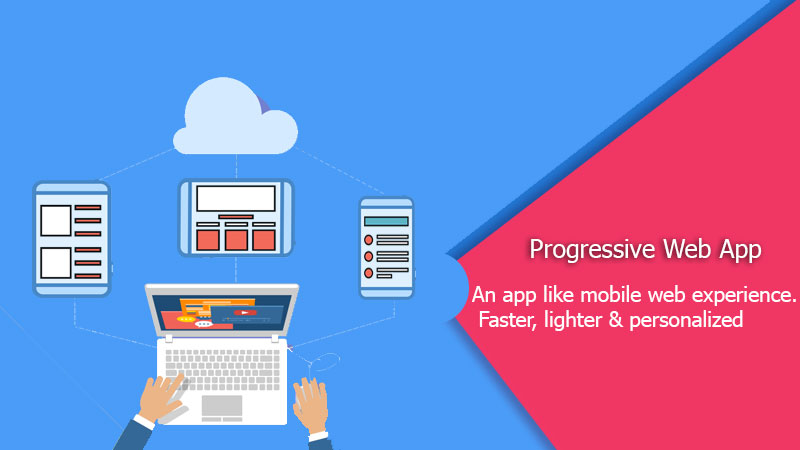
Progressive Web Apps is relatively new to the marketing technology. The term coined by Google Chrome developers for software development methodology was launched in 2015.
At the Chrome Dev Summit and is an engineered fusion of features of both a website and an application. It makes full advantage of modern browser features while behaving like any other application on your home screen. It uses the basic HTML, CSS and JavaScript coding, However, what differentiates it from the regular website and application is the list of 10 key features of PWA web app as listed by Google Developers:
Contents
Top 10 Features of Progressive Web App Will Make Your Web App smarter.
Safe– (progressive web apps vs website ) Progressive web apps work with native APIs and service workers and deals with sensitive information. The benefit here lies in the fact that it can only be operated through HTTPS servers.
This prevents man-in-the-middle-attacks and ensures that the content is not meddled with. This provides the user with more ease than that provided by websites or applications.

Progressive– These are built on progressive app enhancement as a core tenant, this makes it easily available on all devices irrespective of browser choices. It also makes use of the benefits of the device and customises itself accordingly.
Progressive web app Framework
Responsive– With the use of a simple UI, CSS libraries and frameworks like Bootstraps, progressive apps makes itself easily adaptable to all kinds of devices.

Connectivity Independent– Progressive web app service worker allows the progressive app (PWA app) to work even when there is low quality or no internet connection. Some mobile apps are cached partially and certain features become available to the user offline.
In recent trends all source code and resources can be saved locally on the device, thus the app becomes completely available both online and offline.
Application Like– Built on the concept of app shell, the (PWA) progressive web app is initially cached on the device with a shell and minimal page refreshers. The shell is always available on the device for the reference of the user like a native application on the device.
It usually contains all dynamic UI elements, these are available only online. When offline the app shows a cached app interface and related message in place of a blank page. The content on the shell changes frequently, however, an inbuilt shell can also be made by saving the app interface on the device, thus making it available when both online and offline.

Fresh– New content is easily available to the user due to the service worker update process. Once a website is cached, the Progressive web apps will automatically load from the device’s local storage. However, if any major change is made to the service worker, the page automatically, downloads and installs the new version when the page is opened.

Discoverable – According to Simpalm, a progressive web app development firm, “Since PWA web apps are websites these should be easily discoverable on search engines. This helps to detect the web page and in turn, can be added to the home screen according to your preference.”

Re-engageable – Downloading of an app does not guarantee positive interaction from the clients. The process is time-consuming and before the interaction ever takes place the application is usually removed from the device.
Here, tools like push notification come handy as instant pop-ups help establish and engage the virtual relation with the user and also assures positive leads.

Installable– When it comes to a pwa app, the hustle around an app store to download a useful app is removed completely. The PWA web app can be downloaded from the main website using Google Chrome either by clicking on the pop-up asking to be added to the main home screen or through the Chrome browser menu.
The pop-up first meets with a set of demands from the Service Worker. Once the web application is installed, it behaves exactly like a native app, however, it occupies much less storage on the device and directs the user to the website when the app is reused.

Linkable– A progressive web application is not required to share and install the app like Play Store. These can directly be accessed by sharing the page URL.

Though PWA progressive web app has not yet gained popularity, it only seems to be providing positive features when compared to both websites and apps. It is, however, highly depended on the individual SEO of the company, as this helps establish and develop the company’s online presence.

























 Email
Email SMS
SMS Whatsapp
Whatsapp Web Push
Web Push App Push
App Push Popups
Popups Channel A/B Testing
Channel A/B Testing  Control groups Analysis
Control groups Analysis Frequency Capping
Frequency Capping Funnel Analysis
Funnel Analysis Cohort Analysis
Cohort Analysis RFM Analysis
RFM Analysis Signup Forms
Signup Forms Surveys
Surveys NPS
NPS Landing pages personalization
Landing pages personalization  Website A/B Testing
Website A/B Testing  PWA/TWA
PWA/TWA Heatmaps
Heatmaps Session Recording
Session Recording Wix
Wix Shopify
Shopify Magento
Magento Woocommerce
Woocommerce eCommerce D2C
eCommerce D2C  Mutual Funds
Mutual Funds Insurance
Insurance Lending
Lending  Recipes
Recipes  Product Updates
Product Updates App Marketplace
App Marketplace Academy
Academy


